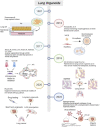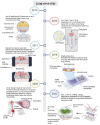Advanced lung organoids and lung-on-a-chip for cancer research and drug evaluation: a review
- PMID: 38026900
- PMCID: PMC10662056
- DOI: 10.3389/fbioe.2023.1299033
Advanced lung organoids and lung-on-a-chip for cancer research and drug evaluation: a review
Abstract
Lung cancer has become the primary cause of cancer-related deaths because of its high recurrence rate, ability to metastasise easily, and propensity to develop drug resistance. The wide-ranging heterogeneity of lung cancer subtypes increases the complexity of developing effective therapeutic interventions. Therefore, personalised diagnostic and treatment strategies are required to guide clinical practice. The advent of innovative three-dimensional (3D) culture systems such as organoid and organ-on-a-chip models provides opportunities to address these challenges and revolutionise lung cancer research and drug evaluation. In this review, we introduce the advancements in lung-related 3D culture systems, with a particular focus on lung organoids and lung-on-a-chip, and their latest contributions to lung cancer research and drug evaluation. These developments include various aspects, from authentic simulations and mechanistic enquiries into lung cancer to assessing chemotherapeutic agents and targeted therapeutic interventions. The new 3D culture system can mimic the pathological and physiological microenvironment of the lung, enabling it to supplement or replace existing two-dimensional culture models and animal experimental models and realize the potential for personalised lung cancer treatment.
Keywords: 3D culture system; drug evaluation; lung cancer; lung organoid; lung-on-a-chip.
Copyright © 2023 Zhu, Zhang, Guo, Kuang, Li, Wu, Mo, Zhang, Gao and Tan.
Conflict of interest statement
The authors declare that the research was conducted in the absence of any commercial or financial relationships that could be construed as a potential conflict of interest.
Figures





Similar articles
-
Bioengineering-inspired three-dimensional culture systems: Organoids to create tumor microenvironment.Gene. 2019 Feb 20;686:203-212. doi: 10.1016/j.gene.2018.11.058. Epub 2018 Nov 24. Gene. 2019. PMID: 30481551 Review.
-
Three-Dimensional Organoids in Cancer Research: The Search for the Holy Grail of Preclinical Cancer Modeling.OMICS. 2018 Dec;22(12):733-748. doi: 10.1089/omi.2018.0172. OMICS. 2018. PMID: 30571609
-
A one-stop microfluidic-based lung cancer organoid culture platform for testing drug sensitivity.Lab Chip. 2019 Sep 7;19(17):2854-2865. doi: 10.1039/c9lc00496c. Epub 2019 Aug 1. Lab Chip. 2019. PMID: 31367720
-
Tumor organoids: synergistic applications, current challenges, and future prospects in cancer therapy.Cancer Commun (Lond). 2021 Dec;41(12):1331-1353. doi: 10.1002/cac2.12224. Epub 2021 Oct 29. Cancer Commun (Lond). 2021. PMID: 34713636 Free PMC article. Review.
-
Exploration of organoids in ovarian cancer: From basic research to clinical translation.Transl Oncol. 2024 Dec;50:102130. doi: 10.1016/j.tranon.2024.102130. Epub 2024 Sep 19. Transl Oncol. 2024. PMID: 39303357 Free PMC article. Review.
Cited by
-
Tumor-on-chip platforms for breast cancer continuum concept modeling.Front Bioeng Biotechnol. 2024 Oct 2;12:1436393. doi: 10.3389/fbioe.2024.1436393. eCollection 2024. Front Bioeng Biotechnol. 2024. PMID: 39416279 Free PMC article. Review.
-
3D cell culture models in research: applications to lung cancer pharmacology.Front Pharmacol. 2024 Sep 23;15:1438067. doi: 10.3389/fphar.2024.1438067. eCollection 2024. Front Pharmacol. 2024. PMID: 39376603 Free PMC article. Review.
References
-
- Deinhardt-Emmer S., Rennert K., Schicke E., Cseresnyes Z., Windolph M., Nietzsche S., et al. (2020). Co-infection with Staphylococcus aureus after primary influenza virus infection leads to damage of the endothelium in a human alveolus-on-a-chip model. Biofabrication 12 (2), 025012. 10.1088/1758-5090/ab7073 - DOI - PubMed
Publication types
Grants and funding
LinkOut - more resources
Full Text Sources

